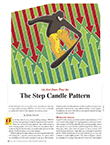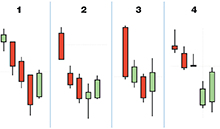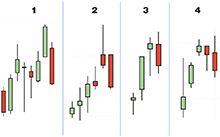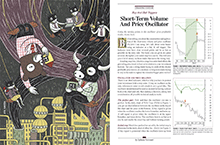 Editor,
Editor,The upstep and downstep patterns presented in Figures 2 & 3 in Sylvain Vervoort’s July 2013 article (“The Step Candle Pattern”), [reproduced here as Figures 1 & 2], leave me with some questions:
LETTERS TO THE EDITOR
The editors of S&C invite readers to submit their opinions and information on subjects relating to technical analysis and this magazine. This column is our means of communication with our readers. Is there something you would like to know more (or less) about? Tell us about it. Without a source of new ideas and subjects coming from our readers, this magazine would not exist.
Address your correspondence to: Editor, Stocks & Commodities, 4757 California Ave. SW, Seattle, WA 98116-4499, or E-mail to editor@traders.com. All letters become the property of Technical Analysis, Inc. Letter-writers must include their full name and address for verification. Letters may be edited for length or clarity. The opinions expressed in this column do not necessarily represent those of the magazine. —Editor
 Editor,
Editor,
The upstep and downstep patterns presented in Figures 2 & 3 in Sylvain Vervoort’s July 2013 article (“The Step Candle Pattern”), [reproduced here as Figures 1 & 2], leave me with some questions:
Jim Von der Wische

FIGURE 1: UPSTEP PATTERN. This reproduction of Sylvain Vervoort’s Figure 2 from his July 2013 article in S&C demonstrates that four scenarios are possible for the upstep pattern.

FIGURE 2: DOWNSTEP PATTERN. As with the upstep pattern, four possible downstep patterns are possible.
Author Sylvain Vervoort replies:
Editor,
Is there a back issue that covers any trading contests or that names the best top traders? Have you published any ratings or do you offer any newsletters on this? Can you recommend a good source for education on trading stocks, options, and forex, as well as technical analysis? I am trying to source the best traders to follow ideas from.
Lorne
As an educational, how-to magazine, we generally do not cover contests or rate individual traders. There are several organizations unrelated to this magazine that do hold contests and can be found on the Internet via a search. If it were ratings on trading systems you seek, we might suggest trying FuturesTruth.com or Collective2.com.
As for following other traders, we’ve recently listed some services in our monthly Trade News & Products section that may interest you; you can review that information for followup.
We do publish a Readers’ Choice Awards section every year in our Bonus Issue, which presents the results of our readers’ votes for their favorite products and services across more than 20 categories of investing software and services. It does not rate individual traders, but it presents a list of services and some resources that our readers find useful.
You also may be interested in our monthly interviews, in which we get to know a trader or analyst in the field and learn about their approach.
As for education on technical analysis itself, simply put, this magazine has been the best source of education on technical analysis since its debut in 1982. We hope you will keep reading to take in all that the technical analysis community has to offer by way of this magazine and by way of our website at www.traders.com. You can also find leads to many other educational resources within our pages or at our site.—Editor
 Editor,
Editor,
I was reading through your website. I respect the work of author Sylvain Vervoort, with his logic and practicality. His SVAPO, or short-term volume and price oscillator (November 2007 S&C), drew my attention as a technical trader. I loved the concept, as I was looking for a way to integrate some insight from volume into my trading setup — that is, something simple (not like Wyckoff concepts) — and that also doesn’t have to go through reading the tape of each trade. Not only do I not want to get into that, but I also don’t have it in my trading platform.
The code for SVAPO has few issues for me. It’s true each one of us can code the same concept differently, especially when it comes to smoothing and averaging, and I would avoid too many smoothings, especially with the TEMA (triple exponential moving averages) or the LR (linear regression). However, there’s a specific line of code that doesn’t make sense to me. I saw a port done by a respected thinkscripter on another site, and unfortunately he ported the same error, translating the study as-is.
Here is the line of code I am referring to (it’s the main logic/formula for calculating the SVAPO):
{SVAPO result of price and volume}
SVAPO:=Tema(Sum(If(haC>(Ref(haC,-1)*(1+cutoff/1000)) AND Alert(vtr>=Ref(vtr,-1),2), vc, If(haC<(Ref(haC,-1)*(1-cutoff/1000)) AND Alert(vtr>Ref(vtr,-1),2),-vc,0)),period)/(vave+1),period);
Volume and its average will be in the millions, so what is the value of adding “1” to a figure like that?
Vervoort’s article on the SVAPO also inspired me to think further of volume integration, so I am now coding another study looking at net directional volume, which is the difference between up & down volume for a given period, as an indicator of volume accumulation and dispersion. It’s what I was looking for, so thank you again for the inspiration.
Keep up all the great and valuable work.
K.
Sylvain Vervoort replies:
Thanks for your letter. The +1 is simply for when there is no volume data available, in which case you would get a division by zero, which would create an error in the formula. With 1, there would be no error message.
Editor,
Congratulations on publishing articles in S&C by Koos van der Merwe. He gets it right, and I hope you will publish work by him more often.
Mike
Thank you for your feedback. Readers who would like to read additional articles by Merwe can visit the Traders.com Advantage area of our website, www.traders.com, which contains online articles published daily. You will find many additional articles there by Merwe.—Editor